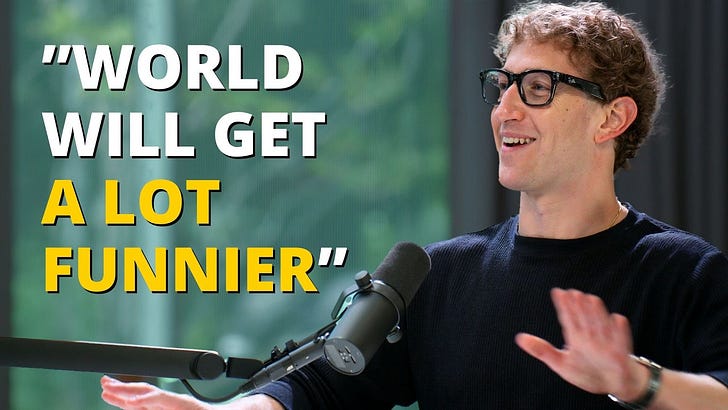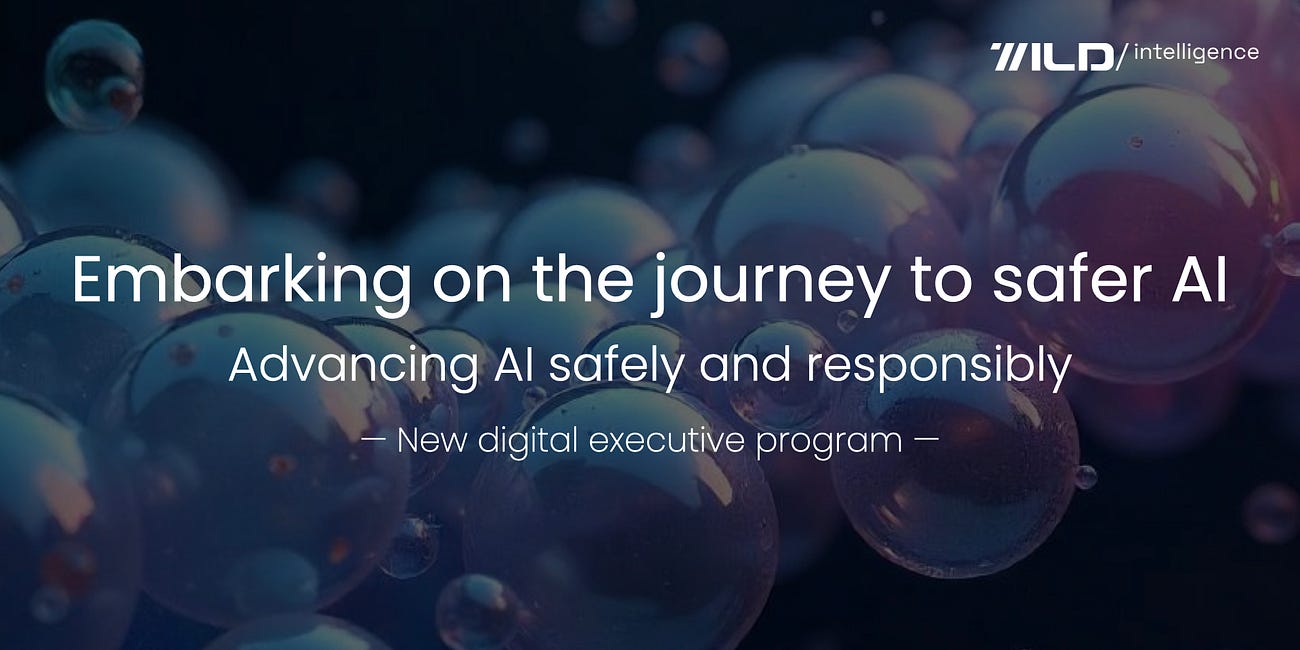🐾 IN TODAY'S WILD
A lean startup defies traditional growth models by reaching millions with a small team.
The influence of AI extends into personal lives, with a reported divorce attributed to a ChatGPT prediction.
New research suggests that our polite language may not significantly impact the quality of AI. Meta unveils its Llama API and AI app, while Anthropic highlights Claude Code's efficiency in development tasks.
Google expands NotebookLM's accessibility, and OpenAI enhances ChatGPT's search capabilities.
Zuckerberg maintains that AI will ultimately increase the demand for human jobs.
🦾 AI DAILY PULSE
“The New York Times profiled a start-up with 28 employees serving nearly 50 million users. That company is us. The traditional startup playbook: raise massive funding, hire hundreds of employees, and worry about profitability "later."”But there's another way. [Grant Lee, CEO at Gamma on LinkedIn]—See my take below.
Greek woman divorces husband after ChatGPT ‘Predicted’ he would cheat on her! [tovima.com]
Researchers now suggest that using words like "please" and "thank you" when interacting with ChatGPT has a minimal impact on quality, contradicting previous studies. [decrypt]
⚡️ TOP TRENDS
Meta unveils Llama API preview, personalized AI app, and Llama Guard 4 at first LlamaCon. [Meta]
Anthropic reveals Claude Code automates dev tasks 2x more than chatbots in real-world use. [Anthropic]
💻 TOP TECHIES
Google enhances NotebookLM: Cross-lingual spoken overviews are now available in over 200 countries. [X]
OpenAI updates ChatGPT search with personalized shopping, multiple citations support, trending queries, and autocomplete. [X]
🔮 WHAT ELSE
Mark Zuckerberg says AI will increase demand for human work, not reduce it, citing Meta’s customer support, where AI could handle 90% of inquiries, lowering costs and enabling more human hires. [Threads]
Mark Zuckerberg details Meta’s Llama 4 roadmap, AGI plans, infrastructure challenges, and open-source AI strategy.
If you enjoy this new version of Wild Intelligence, please forward this email to a colleague or share the publication.
🌟 MY TAKE ON:
“The New York Times profiled a start-up with 28 employees serving nearly 50 million users. That company is us. The traditional startup playbook: raise massive funding, hire hundreds of employees, and worry about profitability "later."”But there's another way. [Grant Lee, CEO at Gamma on LinkedIn]
While the allure of "doing more with less" is undeniable, a deeper, more critical examination reveals potential paradoxes and long-term strategic considerations that demand some attention.
Gamma's triumph hinges on a few key tenets: the cultivation of "versatile generalists," the aggressive integration of AI as "force multipliers," and the rejection of traditional scaling models. However, we must ask: Are we witnessing a sustainable revolution or a high-wire act with inherent limitations?
The mirage of the omnicompetent generalist: While the concept of a highly adaptable workforce is appealing, true mastery often requires deep specialization.
Can individuals truly possess profound expertise across multiple domains, or are they, by necessity, operating at a superficial level in certain areas?
This model risks creating a broad but shallow team, potentially hindering the ability to tackle truly novel and complex challenges that demand focused, cutting-edge expertise. When the low-hanging fruit is gone, will this structure still suffice?
The double-edged sword of AI dependence: Gamma presents its reliance on AI tools for everything from analytics to coding efficiency as a key differentiator. Yet, this deep integration creates a significant dependency.
What happens when these chosen technologies become obsolete, cost-prohibitive, or when competitors develop superior alternatives?
Furthermore, the very nature of AI, while powerful, can also be a black box, potentially masking crucial nuances and hindering the development of truly original, human-driven insights. Are we mistaking technological leverage for genuine strategic advantage?
The scalability ceiling of the "Tiny Team": The current efficiency metrics are impressive, but we must question the long-term scalability of this ultra-lean approach. Serving 50 million users with 28 employees is remarkable, but what about the next order of magnitude?
Can this model adapt to the complexities of managing hundreds of millions or billions of users, navigating diverse global markets, and addressing increasingly intricate regulatory landscapes?
True scalability often requires a more robust and specialized organizational structure.
The hidden costs of hyper-efficiency: The relentless pursuit of maximizing impact per person can inadvertently lead to unsustainable levels of pressure and potential burnout. While he champions resilience, I think we must consider the human cost of constant peak performance.
A small team operating at maximum capacity may lack the redundancy to absorb unexpected challenges or individual departures, creating a fragile ecosystem.
The innovation paradox: Disruptive innovation often emerges from the collision of diverse perspectives and the unstructured exploration of ideas within larger, more heterogeneous teams.
Could Gamma's tightly knit, highly efficient structure inadvertently stifle the kind of creative friction necessary for truly groundbreaking advancements?
Are they optimizing for the present at the expense of future innovation?
Moving beyond
Gamma's story is undoubtedly compelling, offering a stark contrast to the often wasteful exuberance of traditional startups.
However, as decision leaders, we are responsible for looking beyond the captivating narrative and critically assessing the underlying assumptions and potential long-term implications.
Instead of blindly embracing the "tiny team" mantra, we must ask ourselves:
What is the optimal balance between generalist versatility and deep specialization for our specific industry and strategic goals?
How can we strategically leverage AI without creating unsustainable dependencies or sacrificing human ingenuity?
What are the true scalability limits of a hyper-lean organization, and what are the trigger points for strategic expansion?
How do we foster a culture of both high performance and long-term employee well-being?
How can we ensure that efficiency does not compromise crucial diversity of thought and the potential for radical innovation?
Gamma's success offers a valuable case study in challenging conventional wisdom. However, authentic strategic leadership requires us to move beyond the efficiency fetish and engage in a more nuanced and critical evaluation of its long-term viability and broader applicability.
Let us not be seduced by the allure of the outlier without rigorously examining the potential paradoxes that lie beneath the surface.
What do you think?
ON SUBSTACK
HOW WAS TODAY’S EMAIL?
Awesome | Decent | Not great?
At Wild Intelligence, our mission is to build a sharp, engaged community focused on AI, decision intelligence, and cutting-edge solutions.
Over the past year and a half, we have helped over 24,000 decision leaders, board members, and startup founders stay informed and ahead.
We’re passionate about discovering news and get the best in AI, from top research and trending technical blogs to expert insights, opportunities and capabilities.
We connect you to the breakthroughs and discussions that matter, so you can stay informed without the need for endless searching.
👋🏻 About the Daily Wild!
We've launched a significant upgrade to your daily AI intelligence!
Discover the new, concise format of The Daily Wild, designed to bring you the most critical updates on video AI, code generation, and enterprise solutions.
Read the full announcement here: [here].
Reminder
Wild Intelligence is read by executives at prominent companies, including BlackRock, J.P. Morgan, Microsoft, Google, and others. We understand the unique nature of the landscape, and we strive to provide the best experience.
Think of this as your daily advantage in the rapidly evolving world of AI – achieving maximum impact in minimal time!
Premium members
Premium subscribers get the key stories and ideas in tech that week, with analysis of what they meant, together with an exclusive column.
Premium subscribers also have access to the complete archive.
A subscription is $100 for a year. Special price because… It’s time to :-)





